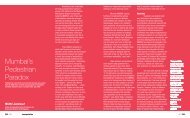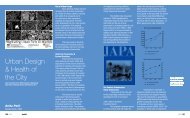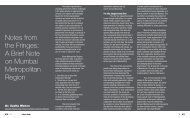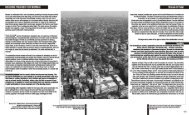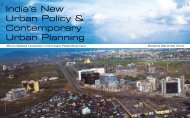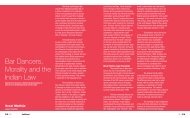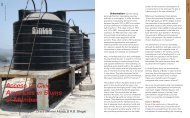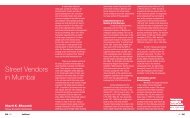You also want an ePaper? Increase the reach of your titles
YUMPU automatically turns print PDFs into web optimized ePapers that Google loves.
city.” How could it not be? Consider itsforging as a thriving metropolis out ofseven islets. Power, ambition, fantasy,and violence -- all had to be enlisted onan extraordinary scale. Its stories containa surfeit of dreams and nightmares, loftyaspirations of cosmopolitan opennessand violent nativist and communalpassions. These are what pulsateMumbai with energy and dynamism.Mumbai grows unabated,a megacity devouring mangroves,swallowing the graceful line ofbungalows, covering the landscape withapartment towers and shantytowns, andenveloping it all in its polluted air. Theinfrastructure creaks under the growingpopulation pressure. The city appearsout of control, its urbanism splintered bynativism and communalism. Where theaging Bal Thackeray and the Shiv Senahave lost some of their roar, Thackeray’snephew, Raj Thackeray, has picked upthe slack. His Maharashtra NavnirmanSamiti (MNS) has grown from strengthto strength, eating into the support of theShiv Sena from which he broke away. Acartoonist like his uncle, Raj Thackerayrides the tiger of populist politics bytargeting North Indian immigrants.These contemporary excesses producedespair and pronouncements of thecity’s death. But as Gillian Tindallreminds us, Mumbai’s problems aredue not to its weakness and declinebut to its strength and dynamism. 3 Thecity’s troubles mount because Mumbaicontinues to draw people by its promise.Vision MumbaiIf mounting problems producedespair, they also generate grand visions.A new vision for Mumbai appeared in2003. It was based on a study conductedby McKinsey and Company for BombayFirst, a nongovernmental organizationof business leaders. Carried out incooperation with the relevant governmentbodies, the study published a reportentitled Vision Mumbai: TransformingMumbai into a World-Class City. Theconsultants developed a databaseand framework for “benchmarkingMumbai” and for the “calibration”of its performance under differentparameters along a spectrum -- from“poor” to “average” to “above average”to “finally world class.” In McKinsey’sjudgment, the city’s slipping economicgrowth and quality of life placed it atthe lower end of the range on a numberof categories. Its recommendation? Achange in Mumbai’s “mind-set.” Insteadof the timid attempts at “incrementalimprovement and de-bottlenecking,”it advocated bold “step jumps.” 4The Maharashtra governmentpromptly succumbed to the seductivevision of Mumbai’s rise to “world-class”status. The chief minister appointeda task force composed of seniorgovernment officials and Bombay First’srepresentative, which endorsed the“world-class” aspiration. Enumeratingthe city’s woes, it painted a pictureof Mumbai hovering “perpetually onthe brink of collapse, with its swellingpopulation, deteriorating environment,income disparities and lack of funds.”The city risked “entering the graveyardof failed cities” unless it took commandof its future. Fortunately, there washope. It recommended seizing thepotential presented by globalization forincreased trade and “the transfer acrossgeographies of investment, technologyand talent” and proposed a ten-yearstrategic plan to improve governance,accelerate economic growth, constructaffordable housing, and developinfrastructure. If financed by a $40billion investment and fast-tracked by aseries of “quick wins” to secure publicsupport, the plan would turn Mumbaiinto a world-class city by 2013. “Theworld is watching. Mumbai is waiting.” 5Here it is once again, an enticingplanned vision of the future city. However,unlike the modernist twin-city project,this initiative comes not from architectsand urban planners but from businessleaders and a global consultancy firm.Echoing the ascendancy of the marketbasedideology, the proposal advocatesa “public-private” partnership, ratherthan a public undertaking. The marketorientation is particularly visible in itsproposals for private capital-based slumrehabilitation.Unfairly holding slumsresponsible for bottling up Mumbai’sgrowth, the document recommendsoffering builders incentives to constructtowers to house the slum dwellers.Particular attention is showered onDharavi -“Asia’s largest slum” -threesectors of which are to be cleared anddeveloped as office and commercialspace. With its proximity to the corporateBandra-Kurla complex, Dharavi is a realestate El Dorado, prompting attemptsto drive away slum dwellers. The citybeautiful can be built only by chasingaway the poor with the help of themarket, supplemented by evictions anddemolitions that miraculously follow theunveiling of “Vision Mumbai.” Severalcritics charge that the “world-classcity” is a dream sold to facilitate thecorporate takeover of the city’s future. 6The “Vision Mumbai” focus onhousing is no accident. Over sixty percentof Mumbai’s population lives in slums.The density of the city’s population is29,000 per square kilometer, the highestin the world -compared with 13,000in Shanghai, 10,000 in New York City,and 5,000 in London. Break it downfurther, and the figure for the densestMumbai ward climbs to over 100,000.The colonial state had resorted to theruse of a housing shortage to launch theBackbay reclamation, a ploy that wasused by the postcolonial governmentin the 1960s to push for further seizureof land from the sea. The aspiration tobecome a world-class city returned to thistried-and-tested tactic in proposing slumrehabilitation. Builders enthusiasticallyendorsed the move. Why would theynot? The Dharavi Rehabilitation Projectis a gold mine for them. As a newspapercomment points out: “Builders get535 acres of prime land, in return forproviding free housing to 52,000 families-plus hospitals, schools, internationalcraft villages, peace parks, art galleries,an experimental theatre and a cricketmuseum!”But since each “apartment”measures only 21 square meters, andthe minimum distance between twobuildings is only 5 meters, there willbe 1.8 million square meters that thebuilders may sell in the commercialmarket. Furthermore, the governmenthas granted an unprecedented floorspace index of 4.1 -- as opposed to thestandard 1.3 -- to attract developers.“No wonder the sharks can’t wait to bite.200 / 07 livelihood07 / 201



